Book contents
- Frontmatter
- Contents
- List of Figures and Tables
- Acknowledgments
- List of Contributors
- Introduction
- 1 A Taxonomy of Dynamic Competition Theories
- 2 Competence Explanations of Economic Profits in Strategic Management: Some Policy Implications
- 3 Innovation and Antitrust Enforcement
- 4 New Indicia for Antitrust Analysis in Markets Experiencing Rapid Innovation
- 5 Innovation and Monopoly Leveraging
- 6 Network Effects and the Microsoft Case
- 7 Technological Standards, Innovation, and Essential Facilities: Toward a Schumpeterian Post-Chicago Approach
- 8 Intellectual Property and Antitrust Limitations on Contract
- 9 Conclusion
- Index
7 - Technological Standards, Innovation, and Essential Facilities: Toward a Schumpeterian Post-Chicago Approach
Published online by Cambridge University Press: 05 June 2012
- Frontmatter
- Contents
- List of Figures and Tables
- Acknowledgments
- List of Contributors
- Introduction
- 1 A Taxonomy of Dynamic Competition Theories
- 2 Competence Explanations of Economic Profits in Strategic Management: Some Policy Implications
- 3 Innovation and Antitrust Enforcement
- 4 New Indicia for Antitrust Analysis in Markets Experiencing Rapid Innovation
- 5 Innovation and Monopoly Leveraging
- 6 Network Effects and the Microsoft Case
- 7 Technological Standards, Innovation, and Essential Facilities: Toward a Schumpeterian Post-Chicago Approach
- 8 Intellectual Property and Antitrust Limitations on Contract
- 9 Conclusion
- Index
Summary
Political controversy to one side, new technology should not be allowed to obscure an old truth. The basic problem is a rerun of the issues for rails and telecommunications: can outsiders connect to the network?
Richard Epstein (1998)Economics is a conservative discipline. Even its revolutions do not stray far from basic accepted principles, and sometimes they merely reassert basic accepted principles. The Chicago School of antitrust analysis scored victory after victory over the Harvard School by an assiduous application of static neoclassical price theory. A new challenger, the so-called post-Chicago approach, accepts the same basic principles, even as it dresses them up in the elegant if improbable clothes of mathematical game theory. What unites these approaches is a devotion to a concept of competition oriented fundamentally around price and quantity. Other dimensions of competition may sneak in, such as competition for “quality” in the abstract. But price theory deals poorly with what is arguably the central impulse of actually existing competition: technological change. “In capitalist reality as distinguished from the textbook picture,” wrote Joseph Schumpeter (1950), the most important form of competition arises not from competition “within a rigid pattern of invariant conditions, methods of production and forms of industrial organization,” but rather from “the new commodity, the new technology, the new source of supply, the new type of organization … competition which commands a decisive cost or quality advantage and which strikes not at the margins of the profits and the outputs of existing firms but at their foundations and their very lives.”
- Type
- Chapter
- Information
- Dynamic Competition and Public PolicyTechnology, Innovation, and Antitrust Issues, pp. 193 - 228Publisher: Cambridge University PressPrint publication year: 2001
- 8
- Cited by



